HARD vs BAT: The Ultimate Showdown in Cryptocurrency Mining
Introduction: HARD vs BAT Investment Comparison
In the cryptocurrency market, the comparison between HARD vs BAT has always been an unavoidable topic for investors. The two not only show significant differences in market cap ranking, application scenarios, and price performance, but also represent different positioning of crypto assets.
HARD Protocol (HARD): Launched in 2020, it has gained market recognition for its decentralized cross-chain lending platform.
Basic Attention Token (BAT): Since its inception in 2017, it has been hailed as a solution for digital advertising, and is one of the cryptocurrencies with high global trading volume and market capitalization.
This article will provide a comprehensive analysis of the investment value comparison between HARD vs BAT, focusing on historical price trends, supply mechanisms, institutional adoption, technological ecosystems, and future predictions, attempting to answer the question investors care about most:
"Which is the better buy right now?"
I. Price History Comparison and Current Market Status
HARD (Coin A) and BAT (Coin B) Historical Price Trends
- 2021: BAT reached its all-time high of $1.9 on November 28, 2021, during the bull market.
- 2017: BAT hit its all-time low of $0.072394 on July 16, 2017, shortly after its initial launch.
- Comparative analysis: HARD has experienced a significant decline from its all-time high of $2.97 on March 17, 2021, to its current price of $0.002924. BAT has also seen a substantial drop from its peak but has maintained a higher price level comparatively.
Current Market Situation (2025-11-27)
- HARD current price: $0.002924
- BAT current price: $0.2217
- 24-hour trading volume: HARD $12,336.47 vs BAT $281,080.30
- Market Sentiment Index (Fear & Greed Index): 22 (Extreme Fear)
Click to view real-time prices:
- View HARD current price Market Price
- View BAT current price Market Price


II. Core Factors Affecting Investment Value of HARD vs BAT
Supply Mechanism Comparison (Tokenomics)
- HARD: Initial supply of 200 million tokens, with 60% distributed to the community through liquidity mining, farming, and governance rewards.
- BAT: Maximum supply of 1.5 billion BAT tokens, with initial distribution through ICO and strategic reserves.
- 📌 Historical pattern: HARD's community-focused distribution model aims to drive adoption while BAT's fixed supply creates potential scarcity value.
Institutional Adoption and Market Applications
- Institutional holdings: BAT has attracted more institutional interest with Brave browser integration and advertising partners.
- Enterprise adoption: HARD Protocol provides lending services within the Kava ecosystem, while BAT powers the Brave browser's advertising ecosystem with over 50 million monthly active users.
- Regulatory attitudes: BAT has generally received positive regulatory reception due to its transparent advertising model, while HARD operates within DeFi regulatory frameworks.
Technical Development and Ecosystem Building
- HARD Protocol technical upgrades: Integration with Kava's cross-chain lending platform, supporting multiple cryptocurrencies for lending/borrowing.
- BAT technical development: Continued integration with Brave browser, self-serve advertising platform, and creator verification system.
- Ecosystem comparison: HARD focuses on DeFi lending services within Kava, while BAT has broader applications in digital advertising, content creation, and browser integration.
Macroeconomic and Market Cycles
- Performance in inflationary environments: BAT may offer better inflation protection due to wider adoption and established user base.
- Macroeconomic monetary policy: Both tokens show sensitivity to broader crypto market trends influenced by interest rates and dollar strength.
- Geopolitical factors: BAT's global browser distribution provides wider exposure, while HARD remains primarily tied to DeFi market dynamics.
III. 2025-2030 Price Prediction: HARD vs BAT
Short-term Prediction (2025)
- HARD: Conservative $0.0015635 - $0.00295 | Optimistic $0.00295 - $0.003363
- BAT: Conservative $0.200517 - $0.2253 | Optimistic $0.2253 - $0.241071
Mid-term Prediction (2027)
- HARD may enter a growth phase, with expected price range $0.0027221656 - $0.0045605112
- BAT may enter a steady growth phase, with expected price range $0.215463402 - $0.323195103
- Key drivers: Institutional capital inflow, ETF development, ecosystem growth
Long-term Prediction (2030)
- HARD: Base scenario $0.0043777990914 - $0.00459668904597 | Optimistic scenario $0.00459668904597
- BAT: Base scenario $0.3577799171583 - $0.422180302246794 | Optimistic scenario $0.422180302246794
Disclaimer: The above predictions are based on historical data and market analysis. Cryptocurrency markets are highly volatile and subject to various unpredictable factors. These projections should not be considered as financial advice or guarantees of future performance. Always conduct your own research and consult with financial professionals before making investment decisions.
HARD:
| 年份 | 预测最高价 | 预测平均价格 | 预测最低价 | 涨跌幅 |
|---|---|---|---|---|
| 2025 | 0.003363 | 0.00295 | 0.0015635 | 0 |
| 2026 | 0.00391406 | 0.0031565 | 0.00183077 | 7 |
| 2027 | 0.0045605112 | 0.00353528 | 0.0027221656 | 20 |
| 2028 | 0.00445268516 | 0.0040478956 | 0.002145384668 | 38 |
| 2029 | 0.0045053078028 | 0.00425029038 | 0.0021676480938 | 45 |
| 2030 | 0.00459668904597 | 0.0043777990914 | 0.004027575164088 | 49 |
BAT:
| 年份 | 预测最高价 | 预测平均价格 | 预测最低价 | 涨跌幅 |
|---|---|---|---|---|
| 2025 | 0.241071 | 0.2253 | 0.200517 | 1 |
| 2026 | 0.25650405 | 0.2331855 | 0.13058388 | 5 |
| 2027 | 0.323195103 | 0.244844775 | 0.215463402 | 10 |
| 2028 | 0.41750931033 | 0.284019939 | 0.27549934083 | 28 |
| 2029 | 0.3647952096516 | 0.350764624665 | 0.19993583605905 | 58 |
| 2030 | 0.422180302246794 | 0.3577799171583 | 0.207512351951814 | 61 |
IV. Investment Strategy Comparison: HARD vs BAT
Long-term vs Short-term Investment Strategy
- HARD: Suitable for investors focused on DeFi lending potential and ecosystem growth
- BAT: Suitable for investors seeking established user base and digital advertising exposure
Risk Management and Asset Allocation
- Conservative investors: HARD 10% vs BAT 90%
- Aggressive investors: HARD 30% vs BAT 70%
- Hedging tools: Stablecoin allocation, options, cross-currency portfolio
V. Potential Risk Comparison
Market Risk
- HARD: Higher volatility due to smaller market cap and DeFi sector fluctuations
- BAT: Exposure to digital advertising market trends and browser adoption rates
Technical Risk
- HARD: Scalability, network stability within Kava ecosystem
- BAT: Brave browser adoption, smart contract vulnerabilities
Regulatory Risk
- Global regulatory policies may have different impacts on DeFi platforms (HARD) and utility tokens (BAT)
VI. Conclusion: Which Is the Better Buy?
📌 Investment Value Summary:
- HARD advantages: DeFi lending potential, cross-chain capabilities
- BAT advantages: Established user base, integration with Brave browser, digital advertising ecosystem
✅ Investment Advice:
- New investors: Consider a smaller allocation to HARD for DeFi exposure, larger allocation to BAT for more established project
- Experienced investors: Balanced approach with higher HARD allocation for potential growth
- Institutional investors: BAT for broader market exposure, HARD for DeFi sector representation
⚠️ Risk Warning: Cryptocurrency markets are highly volatile. This article does not constitute investment advice. None
VII. FAQ
Q1: What are the main differences between HARD and BAT? A: HARD is a decentralized cross-chain lending platform token, while BAT is a digital advertising token integrated with the Brave browser. HARD focuses on DeFi lending services within the Kava ecosystem, whereas BAT has a broader application in digital advertising and content creation.
Q2: Which token has performed better historically? A: BAT has generally shown better historical performance. It reached its all-time high of $1.9 in November 2021, while HARD's all-time high was $2.97 in March 2021. Currently, BAT maintains a higher price level compared to HARD.
Q3: How do the supply mechanisms of HARD and BAT differ? A: HARD has an initial supply of 200 million tokens, with 60% distributed to the community through various means. BAT has a maximum supply of 1.5 billion tokens, initially distributed through ICO and strategic reserves.
Q4: Which token has greater institutional adoption? A: BAT has attracted more institutional interest due to its integration with the Brave browser and partnerships with advertisers. It also has a larger user base with over 50 million monthly active users of the Brave browser.
Q5: What are the predicted price ranges for HARD and BAT in 2030? A: For HARD, the base scenario predicts a range of $0.0043777990914 - $0.00459668904597. For BAT, the base scenario predicts a range of $0.3577799171583 - $0.422180302246794.
Q6: How should investors allocate their portfolio between HARD and BAT? A: Conservative investors might consider allocating 10% to HARD and 90% to BAT, while more aggressive investors could allocate 30% to HARD and 70% to BAT. The exact allocation should depend on individual risk tolerance and investment goals.
Q7: What are the main risks associated with investing in HARD and BAT? A: HARD faces higher volatility due to its smaller market cap and exposure to DeFi sector fluctuations. BAT is exposed to digital advertising market trends and browser adoption rates. Both tokens are subject to technical risks and potential regulatory challenges in the cryptocurrency space.
Share
Content